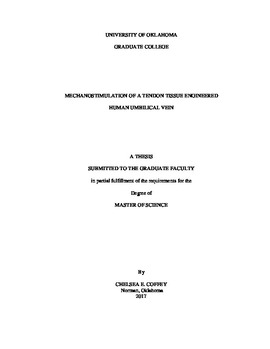| dc.description.abstract | Tissue engineering has become a very popular method when combined with bioreactors for treating disorders of the musculoskeletal system. A scaffold that is biocompatible and bio-absorbable is seeded with the cells then applied a mechanical or chemical stimuli and growth factors that differentiate the cells on the construct into the accurate cell lineage. Tendon tissue engineering is the bridge between engineering, biology, and medicine that has the potential to create a biological substitute for tendon ruptures and restore them close to their full function and capabilities. The need for functional tendons for reconstructive surgeries is clear. Currently, autographs and allographs are a commonly used transplant. However, there are also issues with these solutions such as availability or donor site morbidity. Therefore, a tissue-engineered construct would be a welcome and more beneficial solution for severe tendon injuries. Our hypothesis is that due to the unique regenerative capacity of the human umbilical vein, functional tendons can be developed. The end-point of this project is the development of bio-functional tendons using this novel bio-matrix, to a point that animal studies can be conducted. The ultimate goal is the development of a prosthetic graft with success rates exceeding that of the current benchmark ‘autologous tissue’.
This study investigated three main parameters of stimulating a human umbilical vein (HUV) construct seeded with mesenchymal stem cells (MSCs): frequency, duration, and force. The effects employed were varying the duration (0.5, 1, and 2 hours/day) and the frequency (0.5, 1, 2, cycles/min) of culture in the bioreactor for up to 7 and 14 days with a constant strain rate of 2%. It was found that the highest proliferation rate was observed for the 14 day culture point with the extended (2 hours/day at 1 cycle/min) with a 117% increase compared to the 7 day extended group. Extracellular matrix fiber alignment and quality along with cellular penetration increased significantly with the extended duration and correlates with the upregulation of collagen type I (COL I). Although previous studies indicate that at earlier time points slower and shorter were best for construct development, at the 14 day time point longer durations were beneficial. | en_US |
